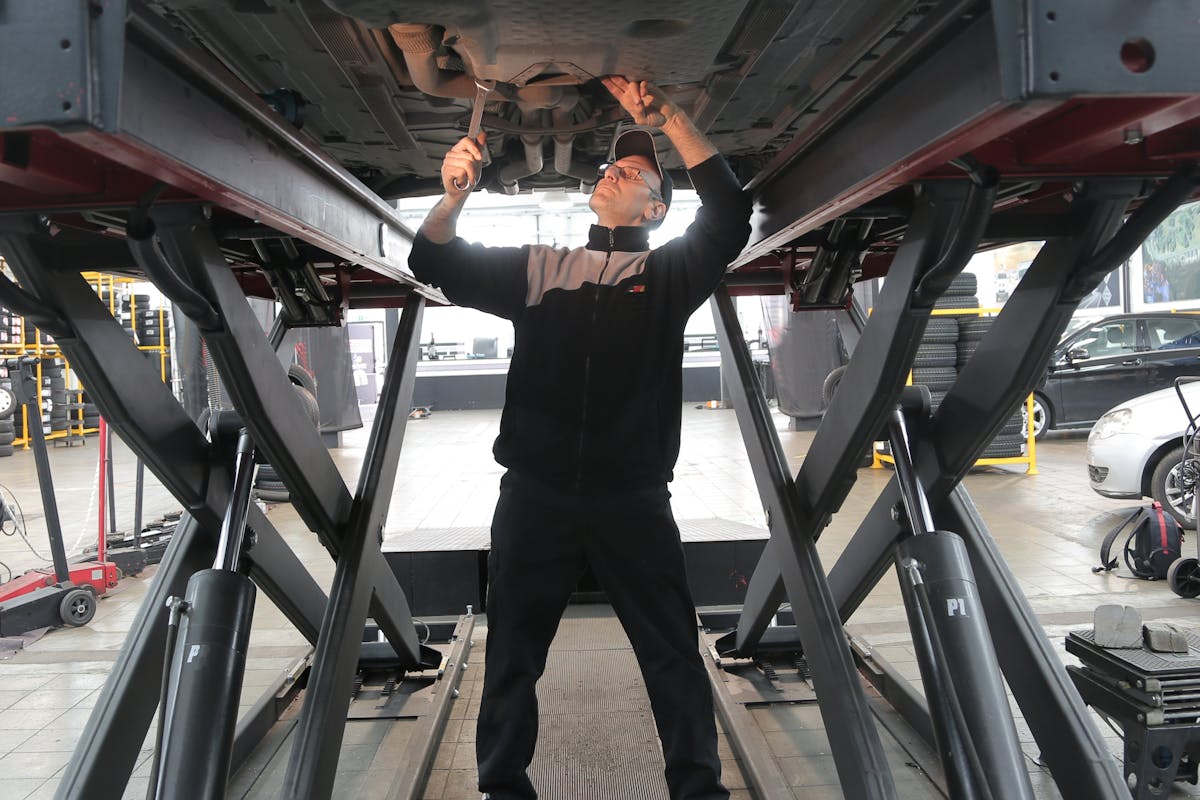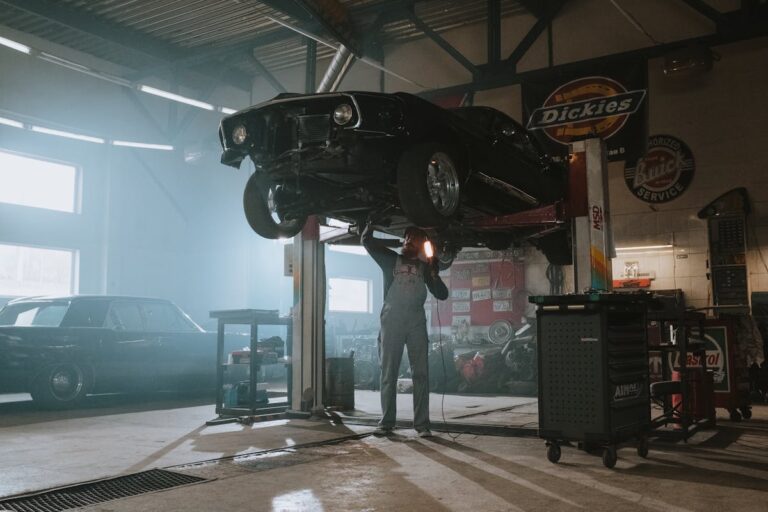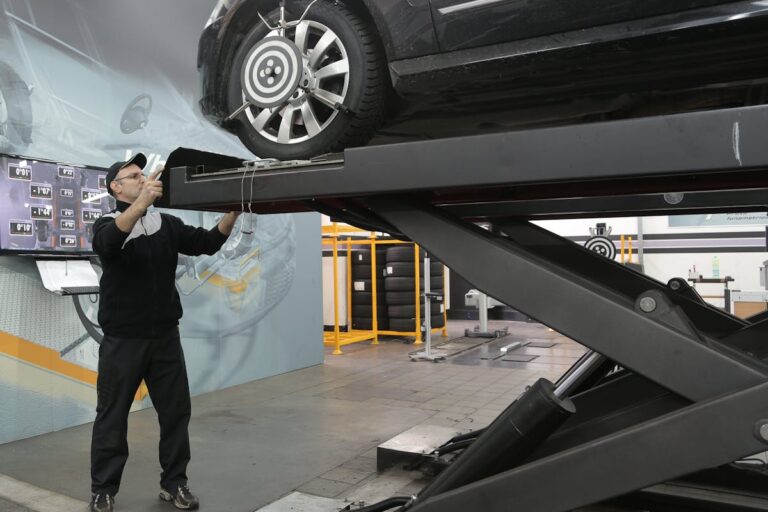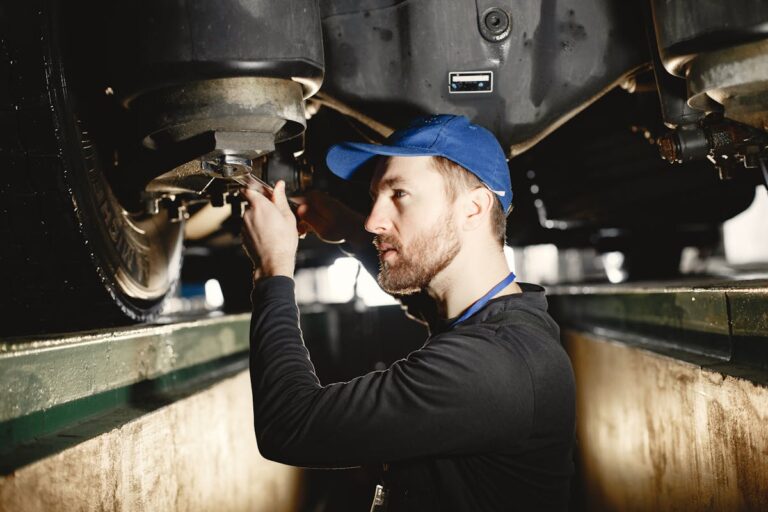The aftermath of a collision can leave your vehicle in a state of disarray, necessitating a range of auto repairs to guarantee it’s roadworthy once more. These can span from structural frame repairs to body and paint restoration, each demanding a unique approach and expertise. However, understanding the extent and nature of these repairs can often be overwhelming, particularly when coupled with the complexities of dealing with insurance claims. In the forthcoming discussion, we will shed light on these critical repair tasks, aiming to provide a thorough guide to effectively navigate through this process.
Assessing Vehicle Damage Post-Collision
In the aftermath of a collision, the twisted metal and shattered glass provide stark evidence to the force of impact. The process of evaluating this damage is vital for both the vehicle owner and the insurance company involved. It is during this damage evaluation that the extent and cost of repairs are determined.
The first step of damage evaluation involves a visual inspection of the vehicle. This will identify any obvious areas of damage such as dents, scratches, or missing parts. However, some damage may not be immediately apparent. It may be hidden beneath the vehicle’s surface or within its internal systems. Consequently, a more thorough inspection may be required, which can include diagnostic tests and scans.
Once all the damage has been identified, the next step is to estimate the cost of repairs. Repair estimates should be exhaustive, covering all necessary parts and labor. This not only guarantees that the vehicle will be restored to its pre-accident condition, but also provides a clear understanding of the financial implications of the collision. These repair estimates are often used for insurance claims, making them an essential part of the post-collision process.
Importance of Frame Repairs
Following a collision, the integrity of a vehicle’s frame often takes a notable hit, requiring meticulous attention during the repair process. This is because the frame, the skeleton upon which the entire vehicle is built, is critical to maintaining the structural safety of the car. Any damage to it can considerably compromise the vehicle’s performance and safety, making frame repairs a top priority post-accident.
Frame integrity is central to the vehicle’s ability to withstand and appropriately distribute force during future accidents, protecting occupants from potential harm. Additionally, a compromised frame can negatively affect the alignment of the vehicle, causing uneven tire wear and poor handling, which may lead to further accidents.
Professional auto repair services use state-of-the-art tools and techniques to assess and restore frame integrity. This may include straightening bent frames, welding cracked sections, and replacing severely damaged parts. The repair process is complex and requires skilled technicians to guarantee the vehicle returns to its pre-accident condition.
Addressing Body and Paint Damage
While frame repairs guarantee the structural safety of a vehicle post-accident, addressing body and paint damage is equally important to restore the vehicle’s aesthetics and protect its resale value.
Body repair techniques vary depending on the extent of the damage. For minor dents and scratches, professionals might use paintless dent repair, a technique that maintains the original paint job while smoothing out the imperfections. However, more significant body damage may require parts replacement or body filler application followed by sanding to guarantee a smooth surface.
Paint restoration options also differ depending on the damage. Small scratches might only need touch-up paint, while deeper scrapes could necessitate a more extensive paint repair involving primer, base coat, and clear coat application. In severe cases, a complete paint job may be necessary to restore the vehicle to its pre-collision state.
It is essential to promptly and correctly repair body and paint damage to prevent rust formation, which could lead to further damage. An expert auto body repair shop will guarantee that these repairs are done correctly, preserving the vehicle’s appearance and value.
Replacing Cracked or Shattered Glass
Following the evaluation and repair of body and paint damages, the next vital step in post-collision auto repairs is addressing any glass damage. This typically involves careful assessment of the damage to determine if a simple repair or a full replacement is required, with particular attention to the windshield due to its essential role in vehicle safety. The process of windshield replacement, from selection of appropriate glass to proper installation, will be our primary focus in this section.
Assessing Glass Damage
In the aftermath of a collision, evaluating glass damage is an essential step in auto repairs. This process involves a careful inspection of all glass components, particularly the windshield which plays a vital role in overall vehicle safety.
The examination of glass damage varies in complexity, depending on the severity and location of the damage. It is important to remember that even small chips or cracks can compromise windshield safety and may necessitate professional glass repair.
Consider the following when evaluating glass damage:
- Inspect the windshield for any visible cracks, chips or shattering. Even minor damage can quickly escalate, compromising safety.
- Examine the side windows and rear glass. These are also susceptible to collision damage.
- Check for any internal glass damage. Sometimes, impact can cause damage that is not immediately visible from the outside.
- Review the integrity of the window seals. Damaged seals can lead to leaks and further damage.
- Consult a professional for a thorough assessment. They can provide a detailed analysis and recommend the most effective repair method.
A detailed inspection guarantees the integrity of the glass components, contributing to overall vehicle safety post-collision.
Windshield Replacement Process
A significant number of auto collision incidents result in cracked or shattered windshields, necessitating a thorough replacement process. The windshield is a vital component in a vehicle’s structural integrity and overall safety, making its repair or replacement incredibly important.
The process starts with removing the damaged windshield carefully to avoid further harm to the vehicle. The next step involves cleaning and preparing the frame for a new windshield. It is essential to remove any remaining adhesive or glass to guarantee a proper fit and secure installation, thereby maximizing windshield safety. Then, a new windshield is installed using a special adhesive that needs to cure for a certain amount of time, typically a few hours to a day. It is vital to wait for the recommended curing time before driving the vehicle to guarantee a firm seal and consequently, safety.
The windshield replacement costs can vary based on the vehicle’s make and model, the extent of the damage, and whether the replacement is done at a dealership or an independent auto repair shop. However, many insurance policies cover windshield replacement, so it’s worth checking with your insurance provider. In any case, it’s important not to delay this necessary repair to avoid compromising safety.
Suspension and Alignment Fixes
Guaranteeing the proper functioning of your vehicle’s suspension and alignment systems is vital after a collision. These systems contribute greatly to the safety, comfort, and overall performance of your vehicle. Any impact can greatly affect these systems, necessitating immediate attention and potential repairs or suspension upgrades.
The benefits of proper alignment are manifold. It optimizes your vehicle’s tire performance, leading to improved fuel efficiency and enhanced driving safety. It also extends the lifespan of your tires by guaranteeing even wear.
It’s important to be aware of the following signs that your vehicle may require suspension and alignment services:
- Unusual tire wear patterns
- Vehicle pulling to one side
- Unsteady, rocking, or bumpy rides
- Difficulty in steering
- Uneven stance or a corner of the car sitting lower
If you notice any of these signs, it’s important to seek professional assistance immediately. Suspension upgrades and alignment adjustments are complex processes best left to trained professionals. They have the necessary knowledge and expertise to guarantee accuracy and precision. Remember, your vehicle’s safety and performance hinge on these important repairs following a collision.

Internal System Checks and Repairs
Upon the conclusion of external body work, attention must be redirected to the internal systems of the vehicle. Evaluating the extent of engine damage, conducting a thorough brake system inspection, and ascertaining transmission repair needs are integral to ensuring peak functionality post-collision. These procedures are not only pivotal for performance but also for the overall safety of the vehicle.
Assessing Engine Damage
Often, the aftermath of a collision can result in significant engine damage that goes unnoticed until it’s too late. The engine, being the heart of your vehicle, demands immediate and detailed inspection to evaluate any hidden damages.
Engine diagnostics and performance analysis play a critical role in identifying potential issues. This process involves an extensive check of the engine’s components and systems to determine the extent of the damage and the necessary repairs.
Here are the main steps involved in evaluating the engine damage:
- Visual Inspection: Check for obvious signs of damage like fluid leaks, cracked or broken parts.
- Engine Diagnostics: Use advanced diagnostic tools to read error codes and identify potential issues.
- Performance Analysis: Examine the engine’s performance under various conditions to identify irregularities.
- Internal Inspection: Check internal parts for damage, including the pistons, valves, and cylinders.
- Repair Plan: Based on the findings, develop a detailed repair plan.
The importance of a thorough engine inspection after a collision cannot be overstated. A well-maintained engine guarantees efficient performance, longevity, and safety. Ignoring potential engine damage can lead to costly repairs down the road, or worse, a complete engine failure.
Brake System Inspection
Just as fundamental as the engine, the brake system of your vehicle demands rigorous inspection following a collision. An impact, even if it seems insignificant, can compromise the functionality of the brake system, posing potential risks to your safety. A thorough brake system inspection is indispensable to guarantee the continued safe operation of your vehicle.
The first step in a brake system inspection involves checking the brake fluid. It is vital as it transfers the force created when you press the brake pedal, subsequently stopping the vehicle. Following a collision, there may be the possibility of brake fluid leakage or contamination, which can severely affect braking performance.
Next, the brake pads must be inspected. These components bear the brunt of the braking force and are prone to wear and tear. A collision can accelerate this process or cause uneven wear patterns, leading to decreased braking performance and potential safety issues. Additionally, any signs of damage or excessive wear on the brake pads calls for immediate replacement.
Transmission Repair Needs
Moving from the brake system, another important part of the vehicle that may require attention following a collision is the transmission. This complex component is responsible for shifting gears and propelling your vehicle forward or backward. A collision can create internal damage to your transmission that isn’t immediately noticeable.
Some signs of transmission damage include erratic shifting, unresponsiveness, and transmission fluid leaks. Shifting issues, in particular, can indicate a problem with your transmission’s internal components.
To guarantee your vehicle’s transmission is functioning properly after a collision, consider the following:
- Check for any visible external damage to the transmission
- Keep an eye out for transmission fluid leaks; this fluid is typically bright red and has a sweet smell
- Pay attention to any unusual noises, such as humming or clunking, when your vehicle is in neutral
- Monitor your vehicle for shifting issues, like hard shifts or a delay in movement
- Have your vehicle inspected by a professional mechanic who can perform a thorough internal system check
Proper transmission repair after a collision helps guarantee your vehicle’s longevity and your safety on the road.
Navigating Insurance Claims and Repair Costs
After a collision, a vehicle owner’s journey through the labyrinth of insurance claims and repair costs can be intimidating. It is essential to understand the insurance claim process to guarantee that you receive the best possible outcome for your vehicle repairs. This process begins with notifying your insurer about the accident and providing them with all the relevant details.
Your insurance company will then proceed to evaluate the damage to assess repair cost estimates. This is where an understanding of the repair expenses can be beneficial. Keep in mind that the cost of repairs can vary considerably depending on the extent of the damage, the make and model of the vehicle, and the rates of the auto repair shop.
While your insurer’s estimate might be lower than expected, it is important to remember that you are entitled to a fair market value for your repairs. If you feel the repair cost estimates provided by your insurer are inadequate, consider obtaining an independent appraisal or consulting with an attorney. Maneuvering through the insurance claim process can be a challenging task, but with patience and knowledge, it is manageable. Remember, the goal is to restore your vehicle to its pre-accident condition without incurring unnecessary financial burdens.
Frequently Asked Questions
How Will a Collision Affect My Cars Resale Value?
A collision can considerably affect your car’s resale value due to its collision history, often resulting in resale depreciation. This impact is dependent on the severity of the damage and the quality of repairs performed.
Can I Still Drive My Car After a Minor Collision?
While minor damages from a collision may not immediately impact drivability, it’s vital to prioritize collision safety. An inspection by a professional mechanic is necessary to guarantee there are no hidden issues affecting your vehicle’s performance.
What Should I Do if My Airbags Deployed During the Collision?
If your airbags deployed during a collision, immediate airbag replacement is vital. Additionally, thorough safety inspections should be conducted to guarantee no hidden damage compromises the vehicle’s safe operation in the future.
How Long Will the Repair Process Typically Take After a Collision?
The repair timeline post-collision varies, depending on the severity of damage. Typically, after a thorough collision assessment, repairs can range from a few days for minor issues to several weeks for extensive damage.
Are There Any Preventive Measures to Minimize Damage in Future Collisions?
Implementing preventive measures such as equipping your vehicle with collision avoidance systems and advanced safety technology can greatly minimize potential damage in future collisions, enhancing the overall safety of your driving experience.


